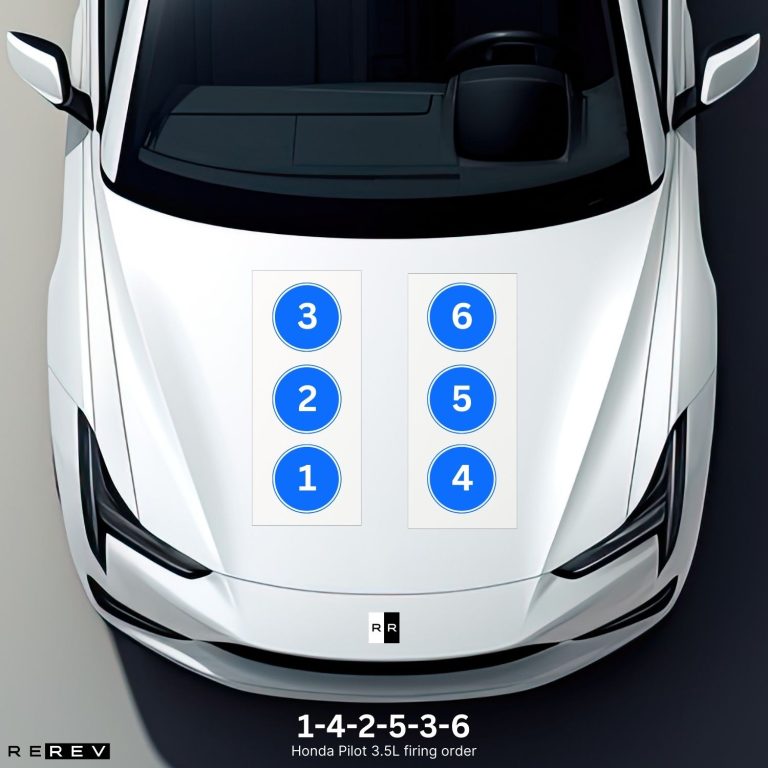Honda Pilot (2002-2023) firing order — diagram & guide

Back in 2002, Honda ventured into the US market of SUV-class cars with the Pilot model which was almost exclusively sold on the North American market. As the years went through, it earned the respect of true automotive enthusiasts and it’s largely due to reliable V6 engines used throughout its production.
So, our team wanted you to have all the details of the Honda Pilot (2002-2023) firing order that may help with your engine’s maintenance. We’ll give you precise instructions on the firing order and the cylinder layout of the engine, so the only thing left for you to do is take care your engine runs smoothly.
| PILOT YEARS | ENGINE | FIRING ORDER |
|---|---|---|
| 1st Gen (2002-2007) | 3.5L V6 | 1-4-2-5-3-6 |
| 2nd Gen (2008-2014) | 3.5L V6 | 1-4-2-5-3-6 |
| 3rd Gen (2015-2021) | 3.5L V6 | 1-4-2-5-3-6 |
| 4th Gen (2022-present) | 3.5L V6 | 1-4-2-5-3-6 |
First-generation Honda Pilot (2002-2007) firing order
The first-gen Honda Pilot model featured the 3.5-liter V6 engine and this one is actually the only engine offered through the Pilot years. It proved to be so reliable and responsive for a V6 that even for a mid-size three-seater SUV no V8 option was ever needed.
So, we’ll take a look at the 3.5-liter V6 and its firing configuration to further explain how the engine’s cycle works.
Honda Pilot 3.5L firing order

The Honda Pilot 3.5L firing order is 1-4-2-5-3-6 and this firing order is the same for all the Honda Pilot models. The engine’s cylinders are ordered front to rear in two cylinder banks each containing three cylinders.
So, the first cylinder is on the passenger’s side bank and it’s the front-most cylinder. Cylinders 2, and 3 follow right up, while the driver’s side bank includes cylinders 4, 5, and 6 going front to rear.
Second-generation Honda Pilot (2008-2014) firing order
Nothing much has changed from the first-gen model to the second generation of the Pilot in terms of the engine used. Once again, the only offered option was a 3.5-liter V6 and the firing order was still 1-4-2-5-3-6.
The engine’s configuration in terms of the cylinder layout didn’t change through the years, so you could find the first cylinder as the front-most passenger’s side cylinder once again.
Third-generation Honda Pilot (2015-2021) firing order
It’s a surprising thing to see a vehicle model featuring the same engine as the only option for three generations straight, but that happened with the Honda Pilot. The 3.5-liter V6 from the third-gen model and the VTEC performance were improved for this one as the engine came with 280 horsepower as opposed to the 250-horsepower second-gen Pilot.
Still, these were just some minor changes and the firing order was still 1-4-2-5-3-6 along with the now standard cylinder configuration.
Fourth-generation Honda Pilot (2022-present) firing order
Finally, the fourth-gen Pilot model also used a 3.5-liter V6 engine with the same firing order and cylinder layout. The fourth-gen Honda Pilot 3.5L firing order is 1-4-2-5-3-6 again since the same base engine block was used to produce the 3.5-liter V6 in this generation.
There were still no added engine options at this time, so that makes the Pilot a rare breed in today’s automotive world where a single engine with the same firing order has been used throughout production.
Our take
While the 3.5-liter V6 engine used in all the Honda Pilot generations is a reliable engine, it doesn’t hurt knowing the firing order and a few other key details.
Now that you are clear with the cylinder positions and their firing sequence, you can at least diagnose misfires and replace spark plugs more easily so your Honda Pilot can push hundreds of thousands of miles.